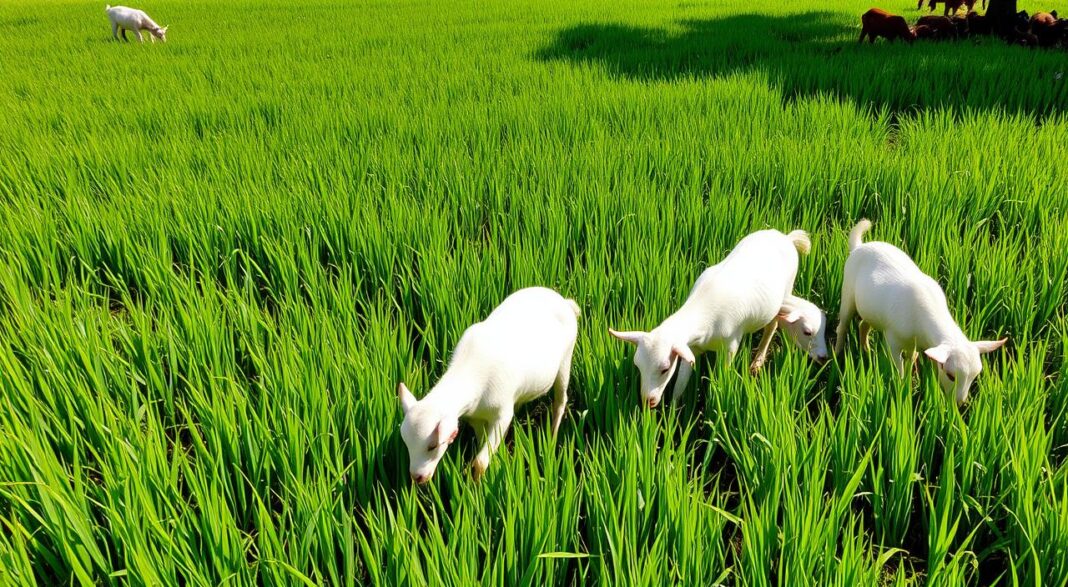The Dangi cow stands out in India’s farms. It’s a local treasure of Gujarat. Known for thriving in tough conditions, it boosts the area’s agricultural resilience. This cow has special genes that have brought attention to its need for protection.
It’s a vital part of Gujarat livestock and shows the importance of genetic diversity. The National Bureau of Animal Genetic Resources (NBAGR) has given it national attention. This has made it a symbol of regional pride and smart farming.
It’s important to know about the Dangi’s genetic makeup to protect biodiversity. This understanding helps ecosystems, economies, and cultural stories. Groups like Anand Agricultural University and Sahjeevan NGO are working hard. They want to keep the Dangi cow’s traits pure.
By doing this, Gujarat is making sure this cow remains part of India’s livestock story. For more about this impressive cow, check out a special website for the Indian veterinary crowd.
Key Points
- The Dangi cow is a tough local breed vital to Gujarat’s animal diversity.
- The NBAGR’s recognition shows how critical it is to save this breed.
- Being strong and diverse are key traits of the Dangi cow.
- Schools and NGOs help protect and manage this breed responsibly.
- For detailed info, there are great resources that highlight the Dangi cow’s importance in farming.
Introduction to the Dangi Cow Breed
The cow comes from Gujarat and holds great cultural and economic importance. It is native to the tribal areas of Central Gujarat, like Dahod. This cow plays a major role in the local ecology and economy. Thanks to studies done by Anand Agricultural University, it gained national recognition in 2019. This helped highlight its importance in conserving genetic resources.
Origins and Recognition
The dangi cow origin is in the forested and hilly areas of Gujarat. It has adapted well to tough weather conditions. This shows how strong its genes are. It’s vital for the area’s biodiversity, supports sustainable farming, and helps the people living there.
Characteristics Unique to the Dangi Cow
Understanding dangi cow characteristics sheds light on how it survives and serves farmers. These cows are small, eat less, and move easily on hilly lands. This makes them good for small farmers. They produce less milk than commercial breeds. However, their milk yield ranges from 175 to 800 kg per lactation. They reach a peak of about 2.65 kg milk roughly 37.78 days after giving birth.
| Milk Yield Characteristics | Value |
|---|---|
| Average Lactation Milk Yield | 511.07 ± 11.60 kg |
| Peak Milk Yield | 2.65 ± 0.03 kg |
| Days to Peak Milk Yield | 37.78 ± 0.26 days |
| Lactation Length | 301.70 ± 3.74 days |
The role of Dangi cattle as indigenous cattle is crucial. It’s not just about their cultural value. They also help diversify the genetic pool and make livestock more resilient. Each trait of the Dangi cow helps it survive. It also shows how they can benefit India’s agricultural scene.
The Significance of the Dangi Cow in Gujarat’s Biodiversity
The Dangi cow significance in Gujarat biodiversity shows the importance of local breeds. These cows help the environment and economy. The Dangi highlights the area’s rich livestock genetic diversity.
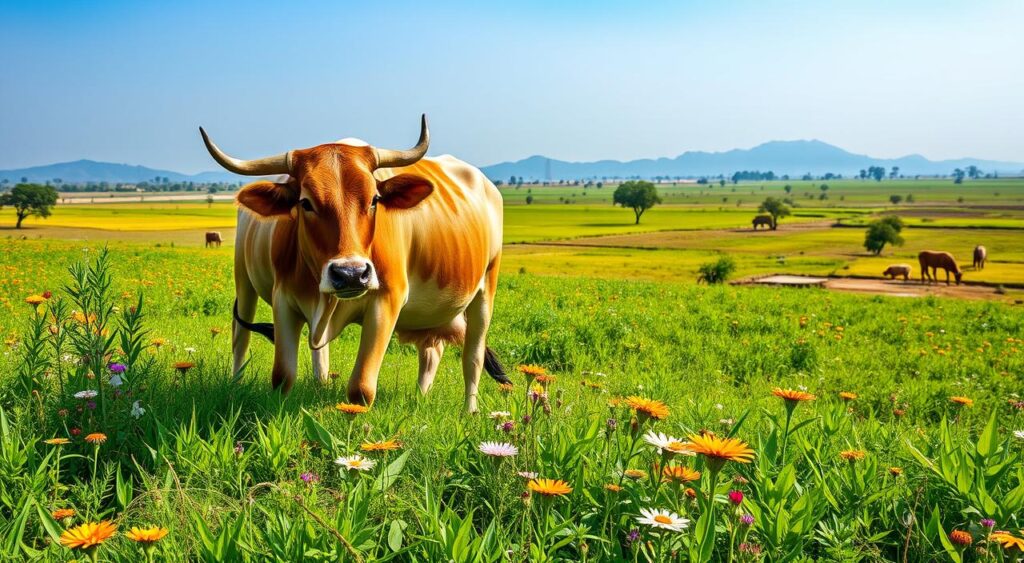
Gujarat’s Indigenous Livestock Contribution
The Dangi cow, along with indigenous livestock breeds like Gir and Kankrej, is key in India. They show Gujarat’s efforts to keep livestock variety. This helps adapt to climate changes and meets farmer needs.
The table below shows how important these animals are biologically and economically:
| Characteristic | Value |
|---|---|
| Average Lactation Milk Yield of Dangi Cows | 175 – 800 kg |
| Livestock Sector Contribution to Total GDP (%) | 3.90 |
| Dangi Adult Male Body Weight | 350.80 ± 3.41 kg (Maximum 416.72 ± 7.12 kg) |
| Number of Biodiversity Management Committees in India as of July 2017 | 62,502 |
| Contribution of Livestock to Agriculture, Fishing, and Forestry Sector (%) | 25.6 |
This info shows the role of livestock genetic diversity. It also tells us how crucial these breeds are to India’s farms. Saving these breeds is key for biodiversity and sustainability in the area.
Livestock Breeds: The Classification of Dangi
The world of cattle breed classification is key to better livestock production. It helps with sustainable farming. The Dangi cattle from India show how varied livestock can be. These cattle, known for dangi cow farming, are used mostly for work. They are strong but give less milk, usually under 500 kg in each cycle.
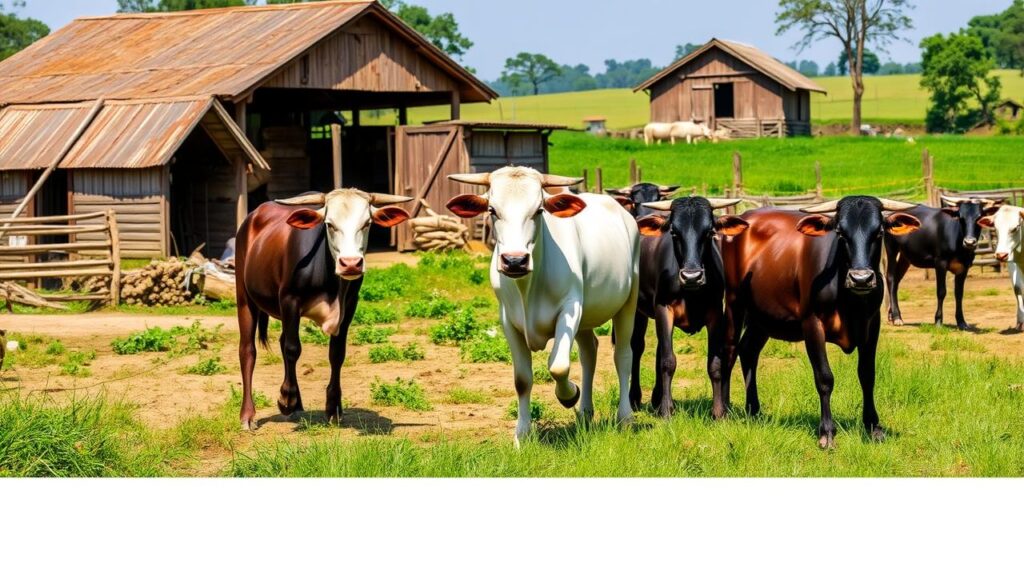
Let’s compare Dangi cattle with other Indian breeds to see differences:
| Breed | Type | Average Milk Yield per Lactation (kg) | Primary Use |
|---|---|---|---|
| Dangi | Draught | < 500 | Work |
| Sahiwal | Milch | 1350 – 2100 | Dairy |
| Gir | Milch | 900 – 1600 | Dairy |
| Kankrej | Dual-purpose | 1300 – 3600 | Dairy & Draught |
| Tharparkar | Dual-purpose | 1660 – 2500 | Dairy & Draught |
| Kangayam | Draught | < 500 | Work |
Livestock genetic improvement and classification help in choosing the right breeding programs. It keeps the unique qualities of indigenous cattle breeds like the Dangi. Knowing these groups is key for policies that support dangi cow farming. It’s also important for efficient cattle raising in India.
To sum up, classifying Dangi and other local breeds is crucial for farming in India. It ensures breeds are used well and their history and fit with the local environment are kept.
Dangi Cow Characteristics and Behavioral Traits
The Dangi cow is truly unique and vital for communities that rely on farming. It is known for its endurance and ability to adapt. These traits are crucial for understanding how cattle can adjust and behave.
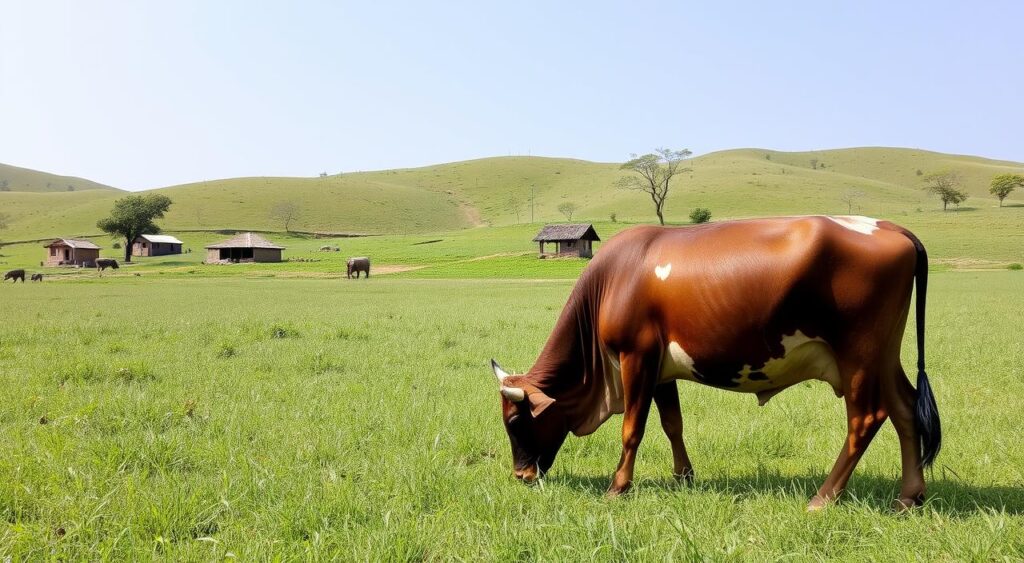
Adaptability to the Mountainous Regions
The Dangi cow facts show its remarkable ability to live in tough, mountainous areas. Its strong body and way of living make it perfect for harsh conditions.
In places with changing temperatures and limited food, these cows are incredibly adaptable. They are key for work that requires strength.
Comparative Analysis with Other Breeds
Compared to breeds like Deoni and Hallikar, Dangi cows shine in draught work. The table below shows the differences in traits and productivity. Dangi cows are specially suited for challenging environments.
| Breed | Average Milk Yield (kg per lactation) | Lactation Period (days) | Average Body Weight (kg) | Draught Capability |
|---|---|---|---|---|
| Dangi | 2110 | 308 | Males: 545, Females: 386 | Highly suitable for rugged terrains |
| Deoni | 1230 | 300 | Not specified | Suitable for flat and dry regions |
| Hallikar | Not specified | Not specified | Not specified | Excellent trotting ability, suitable for heavy draught work |
| Kangayam | Not specified | Not specified | Distinct dark colors on hump, fore and hind quarters | Known for endurance and draught potential |
Dangi cows also have a calm nature, making them easy to handle. This behavior, along with their physical strength, optimizes them for farm work. Their ability to adapt and remain gentle showcases their importance in farming, especially in mountainous areas.
The Economic Importance of Dangi Cows to Local Communities
Dangi cows boost local economies and sustain farming in tough conditions. These native cattle are key for their work power in Central Gujarat’s hills. They show how crucial strong, easy-to-care-for breeds are in difficult areas.
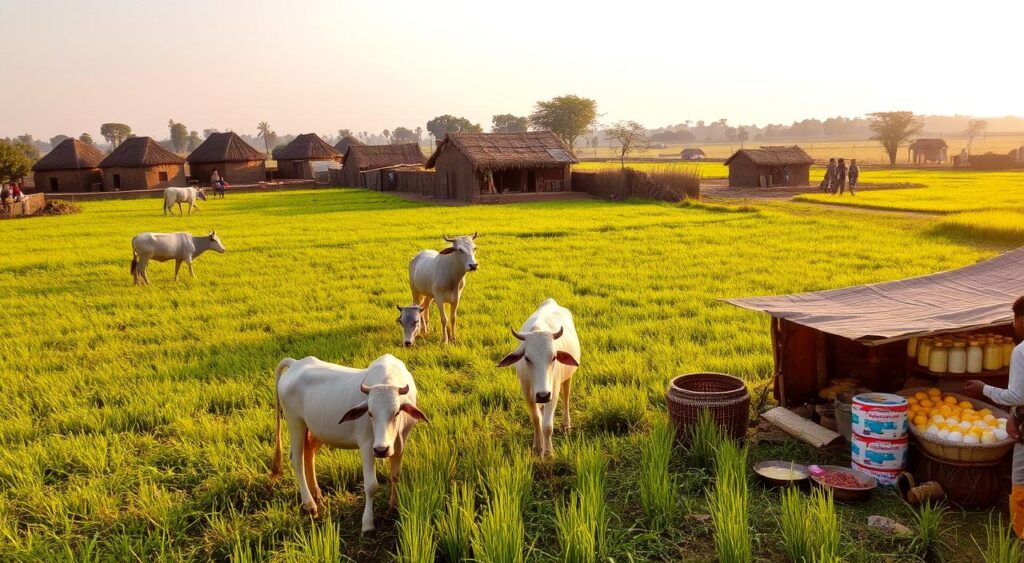
Dangi Bulls in Agriculture
Dangi bulls are valued for their might and endurance. They are crucial for plowing and moving loads in Nasik, Thane, and Ahmednagar. Their ability to handle tough landscapes makes them economically vital to local farms.
Low Maintenance and Sustainability
Dangi cows are also economically beneficial because they’re low maintenance. They eat natural forage, cutting down on feed and care costs. This makes them a sustainable option for small local farmers. They help keep farming sustainable and protect the environment too.
| Breed | Average Milk Yield per Lactation | Average Milk Fat Content | Utilization |
|---|---|---|---|
| Dangi | 430 kg | 4.3% | Draft, Milk |
| Gir | 1200-1800 kg | Varies | Milk |
| Sahiwal | 2725-3175 kg | Varies | Milk |
| Kankrej | 1360 kg | Varies | Milk |
| Hariana | 600-800 kg | Varies | Milk |
Dangi cows make local farming more productive and economically sustainable. By providing milk and labor without big upkeep costs, they’re key to regional farming economies.
Dangi Cow Milk Production and Utilization
The Dangi cow is known for its toughness and ability to adapt. It plays a key role in dairy farming and cattle breeding in India’s rural areas. These cows are not just used in farms but also add value by producing milk. This shows how versatile they are and their role in keeping farming diverse.
Dangi cow milk production stands at about 430 kg per lactation period. The milk has around 4.3% fat. This is less than the milk from higher-yielding breeds like Sahiwal and Gir which make over 1600 kg. But, the Dangi’s milk is high in quality. This is great for making traditional dairy items.
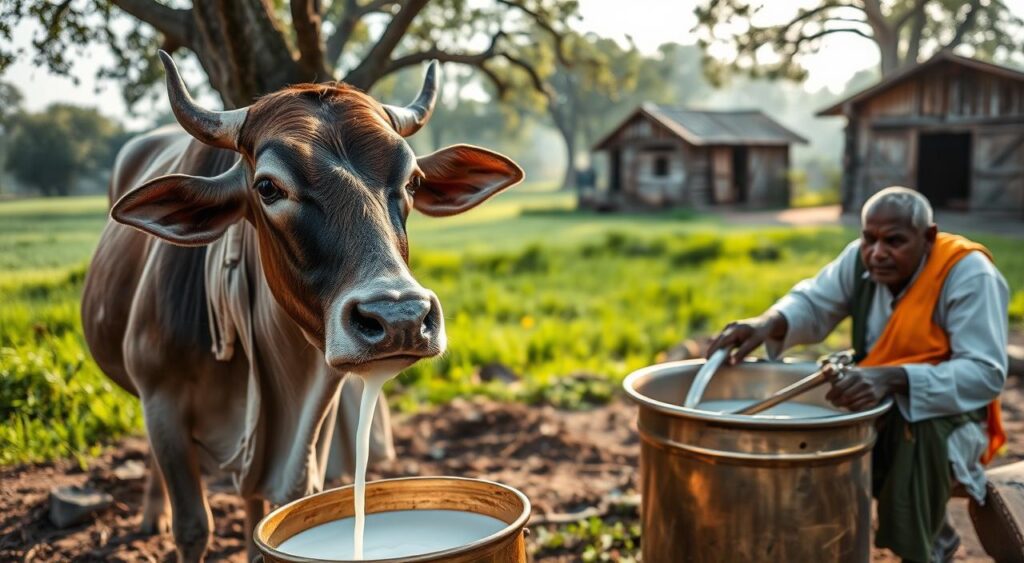
In places where dairy farming is common, Dangi cow milk is crucial. It’s used in making local cheeses and butter. These products are key for the people’s diet and the local economy. The small amount of milk these cows produce makes it even more precious. This shows why it’s important to use milk in a way that lasts.
| Breed | Average Milk Yield per Lactation (kg) | % Fat Content |
|---|---|---|
| Dangi | 430 | 4.3 |
| Hariana | 1140 – 4500 | Varies |
| Jersey | 5000 – 8000 | High |
| Sahiwal | 1350 – 2100 | 4.5 |
| Gir | 1600 | 4.5 |
Dangi cows do well because they can handle local weather well. They are a good choice for small farms facing hard conditions. Focusing on cattle breeding is important. It helps ensure cows can survive by being diverse and adaptable. This is crucial in traditional dairy farming setups.
To wrap it up, Dangi cow milk production may not hit the high numbers of commercial dairy cows. Yet, their role in local milk utilization and farm practices is very valuable. It shows the cow’s worth in India’s rural farm economy.
Efforts in Conservation and Genetic Improvement of Dangi Cows
The dangi cow conservation and genetic improvement play a key role in protecting Gujarat’s ecological and cultural treasures. Educational institutions and government agencies are working together. Their goal is to keep this native breed strong and vigorous through sustainable livestock practices.

Role of Anand Agricultural University and Sahjeevan NGO
Anand Agricultural University is leading research on Dangi cows. They’re improving the breed with science. Sahjeevan NGO works with them to understand these cows better. Together, they’re making strides in enhancing the Dangi’s genetic qualities and their ability to adapt.
This partnership has uncovered the breed’s long history. It shows how Dangi cows have adapted over time, important for their survival and use.
Government Initiatives and Funding
The Gujarat government is also lending its support. They provide funds and policies to protect native cattle. Their work bridges modern science and traditional wisdom. This approach strengthens sustainable livestock practices.
| Statistic | Value | Implication for Dangi Cow Conservation |
|---|---|---|
| Decrease in Indigenous Cattle Population (2007-2012) | 8.94% | Shows the pressing need for dedicated conservation initiatives for breeds like the Dangi |
| Genetic Diversity Loss (Global, Last 100 Years) | 22% | Highlights the worldwide issue of breed extinction and the need for genetic protection |
| Population Growth (Exotic/Crossbred Cattle) | 20.18% | Suggests a growing preference for crossbred varieties, posing risks to native breeds without proper actions |
Through teamwork and strong governance, backed by data, we’re boosting Dangi cow conservation and genetic progress. Merging ancient wisdom with new science is vital. It’s what will keep Dangi cows thriving, benefiting our biodiversity and farming practices.
Farming Practices and the Future of Dangi Cow Farming
The path of Dangi cow farming practices is changing. It blends old traditions with dairy farming innovation. This mix keeps the Dangi breed special but meets today’s market needs. Farmers learn from both old ways and new techniques.

Traditional vs. Modernized Dairy Farming Methods
In places like the Upper Pravara Basin of Maharashtra, about 59% of the cows’ food comes from natural grazing. The other 41% is from stall feeding with harvested fodder. Modern tech could make this more efficient.
However, managing fodder is hard, with shortages up to 80.6% in some areas. There’s a push for new farming methods. These methods must up production and quality without harming the environment or the Dangi cows.
Challenges and Opportunities in Dangi Cow Farming
With fodder needs expected to go up by 23.9% by 2050, farmers face big challenges. Introducing agribusiness challenges, like mixing crop and livestock farming, could help. These systems use local crops like finger millet. They’re good for the soil and cut down on chemicals.
| Farming Aspect | Traditional Practice | Modernized Practice | Impact on Dangi Cow Farming |
|---|---|---|---|
| Grazing | 59% reliance on open land grazing | Enhanced with rotational grazing techniques | Improves soil health and fodder quality |
| Stall Feeding | 41% through harvested fodder | Integration of fodder optimization technologies | Increases efficiency and meets increased fodder demand |
| Fodder Management | Heavy reliance on green fodder with significant deficits | Adoption of crop-livestock integrated systems | Stabilizes fodder supply and enhances sustainability |
| Economic Output | Low output due to traditional methods | Employment of advanced breeding and management practices | Potentially higher milk yields and better financial returns |
Keeping the Dangi cow pure while boosting productivity is key. Mixing local practices with new methods is promising. This approach achieves sustainable agriculture without harming our heritage or the environment. The future of Dangi cow farming looks bright with these new integrations.
Conclusion
The Dangi cow plays a big role in India’s farming culture. These cows are not just numerous but also vital for conserving biodiversity, practicing sustainable farming, and supporting the rural economy. In Gujarat, Dangi cows show the value of saving native cattle and highlight the need for ongoing sustainable veterinary care. They are tough and can adapt to tough mountain areas, which is great for India’s farming future.
There is a strong focus on research to improve the care and management of livestock. Studies on recovery after difficult births show a dedication to animal welfare. They have found that certain treatments work better than traditional methods, improving health and productivity.
Among India’s 37 cow breeds, the Dangi holds a special place. It adds to the country’s reputation as a top milk producer. While some breeds give a lot of milk, the Dangi’s ease of care makes them important for keeping genetic diversity alive.
The Dangi cow is economically important for Gujarat’s villagers and India’s larger farming sector. There’s a big push to better the genetics of the Dangi and other local cows. Keeping these cows safe protects a way of life and is key for the future of farming.
Together, these native cattle and the land offer a way to farm that keeps traditions alive while being sustainable.


